A Brief History of Fremont Street (cont.)
North Side of the Street
Second to Third:
The Fremont Hotel:
On the eastern corner of Second Street once stood a Shell Gas Station. This station opened in 1930 and remained on the corner until the Fremont Hotel was built in 1956. Next to the Shell Station was a Wimpie's Drive-In with the iconic Wimpie's logo. This was one of the places to see and be seen for Las Vegas High students. It was demolished when construction began on a new hotel and casino in 1955.
The original building for the Fremont was designed by architect Wayne McAllister. McAllister was a renowned architect who had also designed the original El Rancho Vegas, the original Sands Hotel and the original Desert Inn on the Strip. Downtown, in addition to the Fremont, he had created the plans for the El Cortez. The owner was Lou Lurie, a man, according to History Professor, Michael Green, who was involved with San Francisco and Miami hotels. He was partnered with Eddie Levenson who arrived via Havana, Cuba. Levenson owned a percentage of the Sands and was reputed to have ties with Meyer Lansky. Lurie also sought out Jerome Mack and Parry Thomas who were with the famed Bank of Las Vegas, the one bank who would loan money to casino owners. The Fremont cost $6 million dollars to build. Compare that to today, where a new hotel can set you back over one or two billion, and you realize quickly how times have changed in Las Vegas. According to author Alan Hess "Breaking the dominance of the Old West style, the state's tallest buidling was strictly modern..it brought Strip amenities and style to Fremont for the first time. It had a pool, a showroom and hotel rooms. It distinquished the large horizontal public spaces on the ground floor from the modular room units in a vertical slab. The tower was faced with a multicolored curtain wall system of interlocking concrete panels and sunscreens. Pinks and red-browns were integral colors. Unlike the Strip of this era that invoked memories of grand Miami resorts, California Modern had come to Fremont Street." (Viva Las Vegas: After Hours Architecture, Alan Hess).
Approximate location of the theater:
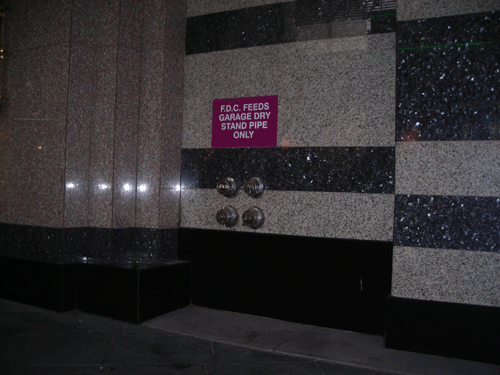
When the Fremont Hotel opened in 1956 it was the first high rise on Fremont Street. At the time, it was the tallest building in the State. People and critics were skeptical that there would be enough tourists and gamblers to fill the 447 rooms. However, the owners had done their homework. They invited Channel 13, the local ABC affiliate, to broadcast from the premises. One of the announcers was local African American businessman, Bob Bailey. Mr. Bailey, of course, could not enter the Fremont via the front door. He mentioned on the air that the Fremont was making his life difficult. While the owners complained, Mr. Bailey won the right to walk through the front door.
It was here that a young singer, working with his brother, got his first taste for performing in Las Vegas. Wayne Newton was barely in his teens when he and his older brother, Jerry, caught their first big break and began performing in the lounge of the Fremont in 1958. Newton, who was too young to be in the casino when he wasn't performing, had to leave the hotel between sets. He could often be found across the street at the soda fountain in White Cross Drugs enjoying a coke or milk shake waiting for his next set to begin. Orgiinally signed for two weeks, the Newton Brothers ended up playing the Fremont for five years, performing six shows a day.
By the mid-1960s, Newton had become a solo act and had been mentored by some of the best of old Hollywood, including Lucille Ball, Jack Benny (for whom Newton was the opening act when Benny took to the road), George Burns and Danny Thomas. When the Flamingo made him offer, he became a headliner and began working the Las Vegas Strip. His days of performing down on Fremont Street would be behind him from that point on.
Levenson and Lurie sold the Fremont Hotel in 1974 to a group headed by local businessman Al Parvin. They, in turn, sold the hotel to the Argent Corp. The Argent Corp. became notorious during the late 1970s and early 1980s for their ownership of the Stardust and Tropicana Hotels as well as their skimming practices. Nick Pileggi and Marty Scorscese immortalized that story, of course, in Casino. According to Dr. Green, Allen Glick the head of the Argent Corp. bought the Fremont for $62 million on a loan from the Teamsters. Though much has been written about the Stardust, Tropicana and the Aladdin's roles in the Casino era, the Fremont was caught up in the scandal as well. Glick and Argent were forced, by federal prosecutors and state gaming officials, to sell the properties and ordered to leave.
The new owners were unable to make a go of the Fremont and for awhile it looked like the hotels days might be numbered. However, Boyd Gaming stepped in and bought the property. Since then they have put a new neon facade on much of the exterior covering McAllister's beautiful mid-century design. However, the tower still has its original facade and gives a visual distinction to what the property once looked like.
When I was much younger, the Fremont Hotel did not take up the entire block. Next to the hotel was the Fremont Theater, the Las Vegas Bootery and Shoe Shine and the Desert Sands Pottery and Trading Post.
The Fremont Theater (approximately where the FDC Feeds Garage Dry Sign is today, was owned by the Nevada Theater Group and run by Lloyd and Edythe Katz. They also ran the Huntridge Theater on East Charleston at Maryland Parkway. The Fremont Theater opened in 1948. The seating capacity was reported to be 800 with a small balcony. Katz had come from Los Angeles after World War II. Katz had many Hollywood connections and a flair for showmanship. He loved to bring out the kleig lights and have old fashioned movie premieres. The Las Vegas Story, Suddenly and Ocean's Eleven all premiered at the Fremont Theater. The Suddenly premiere had the added bonus of Frank Sinatra working the box office. Locals crowded into Fremont Street to see the men in tuxedos and women in fur coats and evening gowns going into the theater for the evening. The Ocean's Eleven premiere was held on August 3rd, 1960 with the stars of the film in attendance. After the premiere, the party continued as the revelers took over the Copa Room at the Sands for the Rat Pack's dinner show. By the mid-1970s, the theater changed hands and became the place to see low-budget horror and Chuck Norris karate films. It was cut up into a small multi-plex before finally being annexed when the Fremont Hotel expanded.

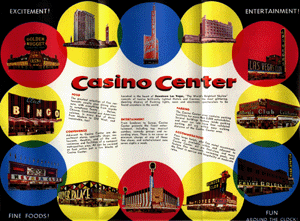

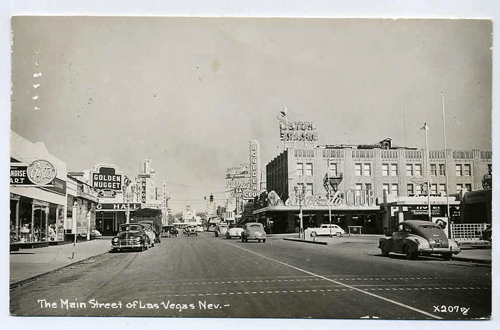
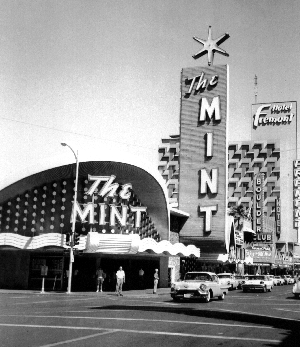
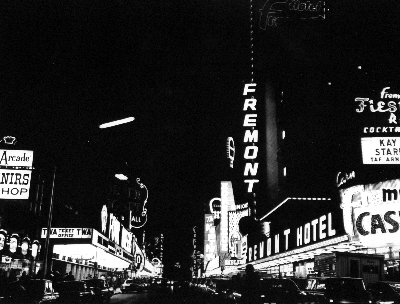
On the western corner of Third and Fremont once stood the Melodie Lane Restaurant. The Melodie Lane was a 20 year landmark on Fremont Street with its dancing letter neon sign beckoning one and all. Owned by Tom and Wilma Panos, the Melodie Lane opened on Dec. 1, 1951 with 24 stools, 30 booths and 29 employees. Sirloin Steak with all the trimmings would set you back $2.50 and a half chicken with rice cost $1.75. When Wayne Newton got hungry in between sets he could be found at the Melodie Lane. Other notables who came there for the food include Western star, local businessman and eventual Lt. Governor, Rex Bell, Marlene Dietrich and Senators Pat McCarran and Alan Bible. In 1971, the Panos' closed the popular eatery and it became the Red Garter before being annexed by the Fremont when they expanded to take over the entire block.
Today the corner where the Melodie Lane once stood:
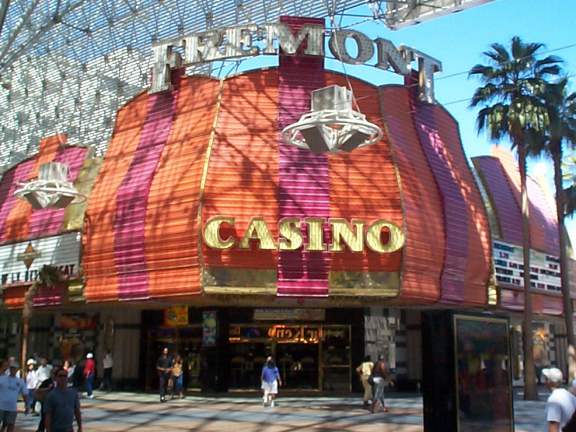
Special thanks to Allen Sandquist and Dr. Michael Green. For more information on Wayne McAllister be sure to read
The Leisure Architecture of Wayne McAllister by Chris Nichols:
http://www.amazon.com/Leisure-Architecture-Wayne-McAllister-Nichols/dp/1586856995/ll-20
For more information on Las Vegas Architecture:
Viva Las Vegas: After Hours Architecture by Alan Hess
Up Next: The businesses that thrived from Third Street to the El Cortez!





